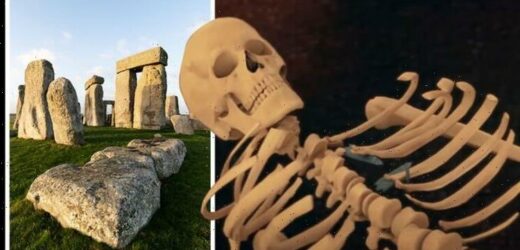Stonehenge: Osteoarchaeologist discusses find of human bones
We use your sign-up to provide content in ways you’ve consented to and to improve our understanding of you. This may include adverts from us and 3rd parties based on our understanding. You can unsubscribe at any time. More info
An exhibition showcasing the ancient megalith begins on Thursday. Its aim is to place Stonehenge in context, so that it looks less alien and more aligned with modern human experience. While the structure itself is not on display — an impossible feat — many of the relics found around it, and materials from across the continent will be on display.
Axe-heads from as far away as the Alps suggest our ancient ancestors were well-linked to their European counterparts, participating in networks of trade and ideas.
Beautiful tools will woo museum-goers, as will intricate ornaments, both of which were often buried alongside their owners as they passed into the next life.
Perhaps the centrepiece of the exhibition is the Nebra Sky Disc: an ancient, stunning map of the night sky created around 3,600 years ago depicting the Pleiades twinkle between the sun and a crescent moon, apparently showing a contrast that was later used by Babylonian astronomers to calculate leap years.
The Sky Disc, made in Germany, also has a boat on it — the boat of the Sun, which serves as a reminder that Stonehenge was built when the pyramids were being raised in Egypt: next to the Great Pyramid at Giza survives the Solar Boat of Khufu, a full-sized ship for him to sail through the sky with the Sun god.


But the ancient Britons would not have been aware of this, and the lands of Germany, a relative stone’s throw away in the modern-world, would have seemed a world away to them.
But a discovery made by researchers in 2018 suggests that the two people may have been more familiar with each other than we think.
Explored during Discovery UK’s documentary ‘Blowing Up History’, osteoarchaeologist Jackie McKinley analysed the remains of two ancient humans found buried beneath the structure.
On examining the two men – one young, around 20 years old, the other older but without his head — she made a groundbreaking discovery.
JUST IN: Putin to hit back and cut THREE key exports to West

Human remains and their bones often hold vital keys about the biological signature of the person, the most specific being where they may have come from.
These signatures can sometimes be traced back to the groundwater consumed by someone in their early years, which can become fixed in the dental enamel of a growing child or bones.
Assessing the older man, his signatures suggested that he may have been from Central Europe, from the region of Germany.
The younger man, too, was found to have spent some of his life in the same place, yet was born at Stonehenge.
DON’T MISS
Stonehenge: Thousands of years of history… hewn in stone [REPORT]
AstraZeneca shares soar as company announces wonder-drug [INSIGHT]
China faces crisis after ‘alarming’ children’s heart discovery [ANALYSIS]


Ms McKinley said: “The fact that we’ve been able to demonstrate that people might have moved several times in their lifetime between long distances is absolutely fascinating.
“What you’ve got is a connection between people over a large geographic area.
“And, whether they kept that connection because of trade, or because of family, or a combination of the two — that is just so modern in many ways, similar to what we would be doing now.”
Two pieces of rare gold metalwork were buried alongside the men, which Ms McKinley claimed hinted at their profession as metal or jewellery workers.

She believes that the young man travelled to Germany in order to take up an apprenticeship.
He would have learned his trade from the older man, and later returned to Stonehenge to make and sell their wares.
These items would have been viewed as highly modern at the time.
We know that the area around Stonehenge was once home to a large settlement — the Durrington Walls — so it is plausible that the site would have once been akin to trading in a present-day city, albeit an extremely scaled-down one.

It is often customary to look down at the people who built Stonehenge compared to the ancient Egyptians and Mesopotamians, people who were all operating in around the same time.
But, the new British Museum exhibition looks to flip that narrative on its head.
It hopes to remove the word so closely related to Stonehenge — “primitive” — and replace it with something more similar to “remote”.
While those ancient Britons were working in a relatively remote part of the world, their works melded into the landscape cleverly, aligning exactly to sunrise on the winter solstice, so people could gather there at the dawn of the shortest day to propitiate the sun to renew their crops.
The World of Stonehenge is at the British Museum, London, from February 17 to July 17.
Source: Read Full Article


